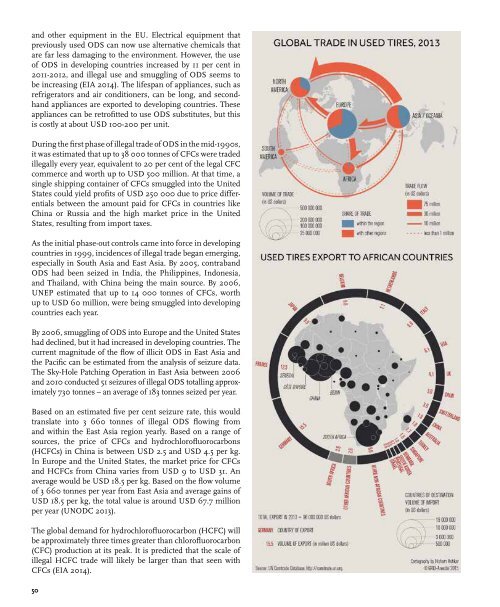WASTE CRIME – WASTE RISKS
6VhhXcA80
6VhhXcA80
You also want an ePaper? Increase the reach of your titles
YUMPU automatically turns print PDFs into web optimized ePapers that Google loves.
and other equipment in the EU. Electrical equipment that<br />
previously used ODS can now use alternative chemicals that<br />
are far less damaging to the environment. However, the use<br />
of ODS in developing countries increased by 11 per cent in<br />
2011-2012, and illegal use and smuggling of ODS seems to<br />
be increasing (EIA 2014). The lifespan of appliances, such as<br />
refrigerators and air conditioners, can be long, and secondhand<br />
appliances are exported to developing countries. These<br />
appliances can be retrofitted to use ODS substitutes, but this<br />
is costly at about USD 100-200 per unit.<br />
During the first phase of illegal trade of ODS in the mid-1990s,<br />
it was estimated that up to 38 000 tonnes of CFCs were traded<br />
illegally every year, equivalent to 20 per cent of the legal CFC<br />
commerce and worth up to USD 500 million. At that time, a<br />
single shipping container of CFCs smuggled into the United<br />
States could yield profits of USD 250 000 due to price differentials<br />
between the amount paid for CFCs in countries like<br />
China or Russia and the high market price in the United<br />
States, resulting from import taxes.<br />
As the initial phase-out controls came into force in developing<br />
countries in 1999, incidences of illegal trade began emerging,<br />
especially in South Asia and East Asia. By 2005, contraband<br />
ODS had been seized in India, the Philippines, Indonesia,<br />
and Thailand, with China being the main source. By 2006,<br />
UNEP estimated that up to 14 000 tonnes of CFCs, worth<br />
up to USD 60 million, were being smuggled into developing<br />
countries each year.<br />
By 2006, smuggling of ODS into Europe and the United States<br />
had declined, but it had increased in developing countries. The<br />
current magnitude of the flow of illicit ODS in East Asia and<br />
the Pacific can be estimated from the analysis of seizure data.<br />
The Sky-Hole Patching Operation in East Asia between 2006<br />
and 2010 conducted 51 seizures of illegal ODS totalling approximately<br />
730 tonnes <strong>–</strong> an average of 183 tonnes seized per year.<br />
Based on an estimated five per cent seizure rate, this would<br />
translate into 3 660 tonnes of illegal ODS flowing from<br />
and within the East Asia region yearly. Based on a range of<br />
sources, the price of CFCs and hydrochlorofluorocarbons<br />
(HCFCs) in China is between USD 2.5 and USD 4.5 per kg.<br />
In Europe and the United States, the market price for CFCs<br />
and HCFCs from China varies from USD 9 to USD 31. An<br />
average would be USD 18.5 per kg. Based on the flow volume<br />
of 3 660 tonnes per year from East Asia and average gains of<br />
USD 18.5 per kg, the total value is around USD 67.7 million<br />
per year (UNODC 2013).<br />
The global demand for hydrochlorofluorocarbon (HCFC) will<br />
be approximately three times greater than chlorofluorocarbon<br />
(CFC) production at its peak. It is predicted that the scale of<br />
illegal HCFC trade will likely be larger than that seen with<br />
CFCs (EIA 2014).<br />
50


